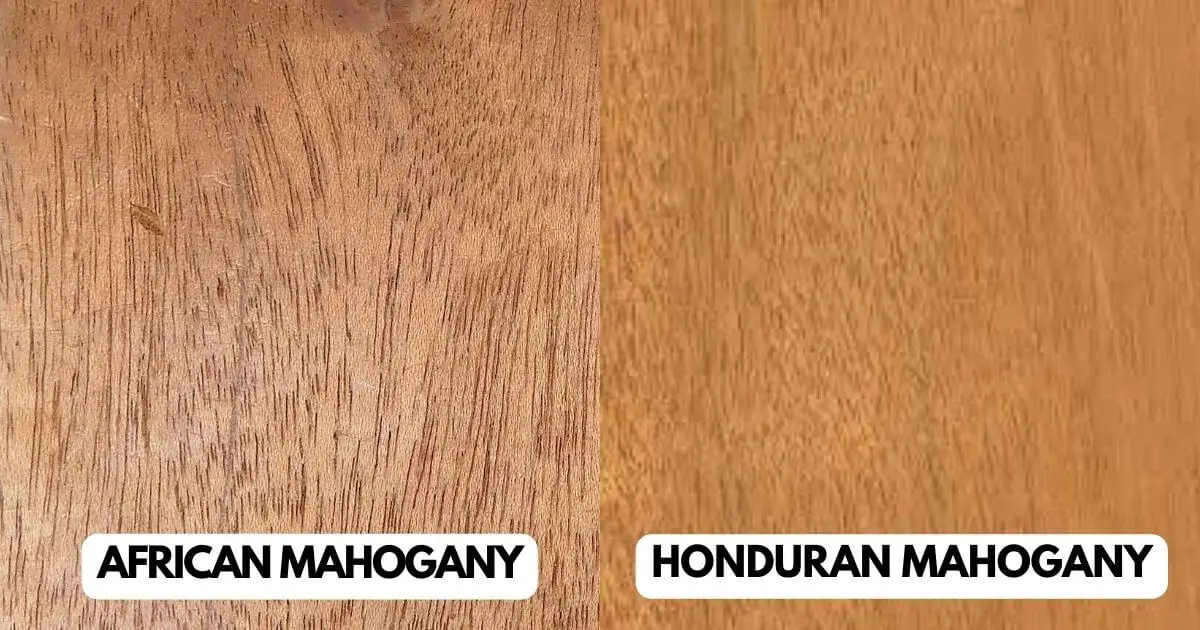Honduran mahogany is more durable and resistant to termites than African mahogany, while African mahogany tends to be darker than Honduran mahogany. Mahogany wood is one of the most attractive woods widely used for furniture and veneers.
There are many species of Mahogany wood. Some Mahogany species are classified into true mahogany or genuine mahogany. Honduran mahogany, Mexican mahogany, and Cuban mahogany are considered true mahogany, while African mahogany is generally considered much closer to mahogany.
African Mahogany
African Mahogany, also known as khaya. It is native to tropical regions of Africa. It has a deep brown color, rot resistance, excellent stability, and workability properties. Making it a popular wood for furniture.
African Mahogany is not considered genuine, but it is very close to Mahogany based on color and grain pattern.
Honduran Mahogany
Honduran mahogany wood is durable, stable hardwood and a species of Meliaceae family plant. It is native to Southern Mexico to central South America. Honduran mahogany is the finest tonewood for making high-quality musical instruments.
Honduran mahogany is commonly known as genuine mahogany, big-leaf mahogany, Brazilian mahogany, and American mahogany. It is considered genuine mahogany.
| # | African Mahogany | Honduran Mahogany |
| Scientific Name | Khaya spp., | Swietenia macrophylla |
| Tree Size | 100-200 ft (30-60 m) tall, 3-6 ft (1-1.8 m) trunk diameter | 150-200 ft (46-60 m) tall, 3-6 ft (1-2 m) trunk diameter |
| Average Dried Weight | 33.9 lbs/ft3 (545 kg/m3) | 36.8 lbs/ft3 (590 kg/m3) |
| Janka Hardness | 850 lbf (3,800 N) | 900 lbf (4,020 N) |
| Crushing Strength | 6,570 lbf/in2 (45.3 MPa) | 6,760 lbf/in2 (46.6 MPa) |
| Shrinkage: Radial | 3.4%, Tangential: 5.7%, Volumetric: 9.3%, T/R Ratio: 1.7 | Radial: 2.9%, Tangential: 4.3%, Volumetric: 7.5%, T/R Ratio: 1.5 |
Uses
African Mahogany and Honduran Mahogany are widely used for making high-quality furniture, cabinetry, veneers, plywood, and turned items.
Mahogany is one of the most popular wood species for its beautiful tone. African and Honduran Mahogany is used for musical instruments (such as guitars and pianos). It has a solid, punchy tone, low overtone content, and a good high-end response.
Mahogany is moisture and weather resistant, making it a suitable wood for boat making.
Appearance
The heartwood of African mahogany ranges from pale pink to deeper reddish brown, while the sapwood is light reddish brown, while the heartwood of Honduran mahogany ranges from pale pinkish brown to darker reddish brown. Like other hardwood, Mahogany also tends to be dark over time.
African mahogany has dark streaks, whereas Honduran Mahogany has lighter, less easily visible streaks.
African Mahogany and Honduran Mahogany have straight and interlocked grain with a good natural luster.
Workability
Both African and Honduran Mahogany can be worked easily with hand and machine tools. They are also easy to finish and give excellent results.
However, mahogany has interlocked and wavy grains, which can sometimes be a problem with machining. Honduran mahogany has a slightly higher density than African mahogany, so use sharp tools to work with it.
African Mahogany Pros and Cons
Pros
- Appearance: African mahogany is known to be a high-quality lumber. The deep reddish brown color and uniform grain pattern of African mahogany make it attractive, and it becomes more lustrous with age and exposure to light.
- Easy to work: African Mahogany is easy to work with, accepts stains, and finishes well, making it versatile for various applications.
Cons
- Poor Insect Resistance: African mahogany is rot-resistant but susceptible to insect attack. Therefore it cannot be used for applications that require prolonged contact with soil.
- Cost: African mahogany tends to be more expensive than other hardwood species. It is an expensive wood due to its high demand and limited availability.
Honduran Mahogany Pros and Cons
Pros
- Stability and Durability: Honduran mahogany is known for its stability, making it less prone to warping and cracking than other wood species. It has a medium density, which makes it a good choice for flooring.
- Rot-resistant: Honduran mahogany is naturally resistant to rot. It can withstand weather and moisture. It does not require an too care and exterior finish like other hardwoods, but the exterior finish enhances its durability.
Cons
- Interlocked Grain: Honduran mahogany wood has interlocked, irregular, or wavy grains, making it difficult to work.
- Allergies: Working with Honduran mahogany can cause allergic reactions such as eye, skin, and respiratory irritation. So be careful while working.
Is Honduran Mahogany Illegal?
Honduran mahogany is neither illegal nor restricted. Due to continuous harvesting, the population of Honduran trees has declined drastically over the past few decades. So it is currently considered a very rare and expensive wood.
Honduran Mahogany can be bought from online or offline stores with many restrictions or paperwork. The government is trying to ensure that there is no illegal logging of rare wood species like Mahogany.
Honduran Mahogany Price?
On average, Honduran mahogany can cost anywhere from $15 to $30 per board foot (1 board foot = 144 cubic inches or approximately 2.36 cm³). The cost of lumber depends on many factors, such as the grade and length of the lumber.
African Mahogany Price Per Board Foot?
The price of African Mahogany can be around $10 to $15 Per Board Foot.
Honduran Mahogany Stain?
Honduran Mahogany is generally easy to stain. Its moderately open grain structure readily accepts and absorbs stains, allowing for a uniform and smooth finish.
Read also : African Mahogany vs Genuine Mahogany

